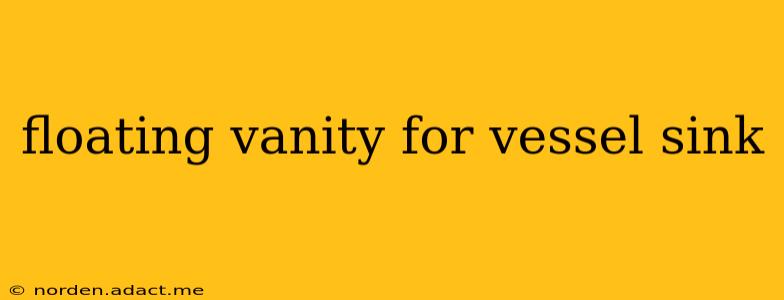A floating vanity for a vessel sink is a fantastic way to create a modern and elegant bathroom design while maximizing space. This combination offers a clean, contemporary aesthetic that's increasingly popular in modern homes. This guide delves into the details of choosing and installing a floating vanity to perfectly complement your vessel sink.
What is a Floating Vanity?
A floating vanity, also known as a wall-mounted vanity, is a bathroom cabinet that appears to be suspended in mid-air. It's attached to the wall using sturdy brackets, leaving the floor completely clear underneath. This creates a sense of spaciousness, especially beneficial in smaller bathrooms. The sleek, minimalist look contributes significantly to the overall design appeal.
Why Choose a Floating Vanity with a Vessel Sink?
The pairing of a floating vanity and a vessel sink is a match made in design heaven. The sleek lines of the vanity beautifully complement the bowl-like shape of the vessel sink, creating a visually stunning and cohesive look. This combination:
- Maximizes Space: The open floor space under the vanity makes the bathroom feel larger and less cluttered. This is particularly advantageous in smaller bathrooms or powder rooms.
- Offers a Modern Aesthetic: The clean lines and minimalist design contribute to a contemporary and stylish bathroom ambiance.
- Enhances Cleaning: The open space under the vanity makes cleaning the floor easier, preventing the buildup of dirt and grime.
How to Choose the Right Floating Vanity for Your Vessel Sink
Selecting the perfect floating vanity involves considering several factors:
- Size and Dimensions: Measure your bathroom space carefully to determine the ideal size of the vanity. Ensure there's adequate space for the vessel sink, faucet, and any additional accessories.
- Material: Floating vanities are available in various materials, including wood, MDF (medium-density fiberboard), and even concrete for a more industrial look. Consider the durability, water resistance, and aesthetic appeal of each option. Wood vanities, particularly those made from water-resistant woods like teak, are popular choices for their elegance and longevity.
- Storage: Assess your storage needs. Some floating vanities offer ample drawer space, while others may be more minimalist. Choose a vanity that provides sufficient storage for your bathroom essentials.
- Style: The style of the vanity should complement your overall bathroom design. Consider the color, finish, and overall aesthetic to ensure it seamlessly integrates into your space.
- Sink Compatibility: Ensure the vanity countertop is compatible with your chosen vessel sink. The cutout should be the correct size and shape to accommodate the sink's dimensions.
What are the Pros and Cons of a Floating Vanity with a Vessel Sink?
Pros:
- Space-saving: Creates a more spacious and open feeling in the bathroom.
- Stylish and modern: Offers a contemporary and elegant look.
- Easy to clean: The open floor space underneath makes cleaning easier.
- Variety of styles and materials: Allows for customization to fit your bathroom's design.
Cons:
- Installation can be complex: Requires wall mounting and may need professional installation for optimal results.
- Limited storage space: Some smaller vanities may not offer ample storage.
- Potential for water damage: Requires proper sealing and installation to prevent water damage.
How to Install a Floating Vanity with a Vessel Sink (General Overview)
Installing a floating vanity is a more complex process than installing a standard vanity. It generally involves:
- Precise Measurements and Marking: Carefully measure the wall to determine the optimal placement of the vanity. Mark the location of the mounting brackets.
- Wall Stud Location: Locate and mark the wall studs to ensure secure mounting.
- Mounting Brackets: Attach the mounting brackets securely to the wall studs using appropriate screws and anchors.
- Vanity Installation: Carefully hang the vanity onto the brackets.
- Plumbing Connections: Connect the faucet and drain lines to the vessel sink and plumbing system.
- Vessel Sink Installation: Carefully place and secure the vessel sink onto the vanity countertop.
- Sealing: Seal the countertop and sink edges to prevent water damage.
Note: This is a general overview. Always consult the manufacturer's instructions for specific installation details and safety precautions. It is often advisable to seek professional installation assistance for floating vanities, particularly if you lack experience with such projects.
What are some common materials used for floating vanities?
Floating vanities are available in a wide range of materials, each offering unique benefits:
- Wood: Offers a classic and elegant look, but requires proper sealing to prevent water damage. Popular choices include teak, oak, and mahogany.
- MDF (Medium-Density Fiberboard): A more affordable option that is relatively durable and easy to work with. Often finished to look like wood.
- Concrete: Provides a modern industrial feel. However, it is heavier than other materials and may require more robust wall supports.
- Laminate: Durable and water-resistant, but might not be as aesthetically pleasing as wood or concrete.
Can I install a floating vanity myself?
While possible for experienced DIY enthusiasts, installing a floating vanity is a more challenging project than installing a standard vanity. Improper installation could result in damage to your wall or the vanity itself, or even lead to plumbing leaks. If you lack experience with home improvement projects, it's recommended to hire a professional installer.
How much does a floating vanity for a vessel sink cost?
The cost of a floating vanity for a vessel sink varies significantly depending on several factors, including the size, material, design, and brand. Prices can range from a few hundred dollars to several thousand dollars.
This comprehensive guide provides a solid foundation for understanding the benefits, selection process, and installation of a floating vanity for your vessel sink. Remember to carefully plan and measure to ensure a seamless and stylish addition to your bathroom.
